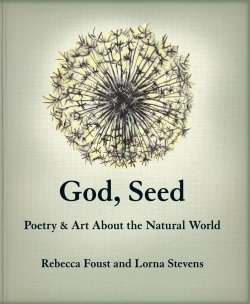God, Seed
Poetry & Art About the Natural World
- 2010 INDIES Winner
- Gold, Poetry (Adult Nonfiction)
Line and image mix organically in God, Seed, the collaborative collection from poet Rebecca Foust and artist Lorna Stevens. Here, Foust’s moving, contemplative poems—focusing on contemporary environmental problems and their human cost—are situated alongside beautiful and evocative images from Stevens. In the presented work of both women, animals and nature tell larger stories of humankind’s struggle, with the poems explicitly discussing pesticide use, animal extinction, and the complicated birth and raising of her autistic son, a topic Foust has mined in her previously published collection and chapbook.
The world captured in God, Seed is vulnerable and already hurt, subject to the whims of human recklessness and forced to reckon with its outcomes. In the poem “Day,” the speaker tells of how “a man / drove his truck / to the barn to shoot / the magpies he’d trapped / in a cage there. Asked why, / he said because I can…” Across the page, a lone bird flies, surrounded by the crosshairs of a gun. Extinction figures as a primary subject in God, Seed. “Last Bison Gone” considers the hubris of human behavior, opening with a stark, damning declaration: “Ours is the curse of the blighted touch / that wilts every green shoot and flower / we mean to admire, keep, re-create / or improve.” Other poems, like “Steward,” and the prose poem “Lazarus,” also examine the meaning of extinction; “Lazarus” leaves the reader with a particularly unforgettable message, as the poem first chronicles extinct species in an alphabetical list as various in name as it is unified in its righteous anger, then lets the reader know that in this case, for once, environmental tragedy has been averted..
God, Seed, while broad in its thematic focus, works in small units—one image per every few pages, and poetic lines as lush and dense as they are short. Foust writes poems with packed words and a layered vocabulary, a style which here suits both its politicized subject and accompanying art. Stevens—whose artwork appears sometimes in black and white, sometimes in stunning color—creates images that truly complement the poems’ themes. For the poem “Dawn Poppies,” five coral poppies bloom on the previous page amidst a sea of white. “Uprising” takes as its mate a single gull in silhouette, wings outstretched as it flies through the blank page.
A variety of media and techniques were used, ranging from watercolor, to acrylic, to charcoal rubbings and often a combination of several.Readers who come to the book through an interest in either contributor will find something moving in God, Seed: each component enhances the other, and both make necessary, compelling commentary on the risks and rewards of immersing oneself in the natural world.
Reviewed by
Rachel Mennies
Disclosure: This article is not an endorsement, but a review. The publisher of this book provided free copies of the book and paid a small fee to have their book reviewed by a professional reviewer. Foreword Reviews and Clarion Reviews make no guarantee that the publisher will receive a positive review. Foreword Magazine, Inc. is disclosing this in accordance with the Federal Trade Commission’s 16 CFR, Part 255.

